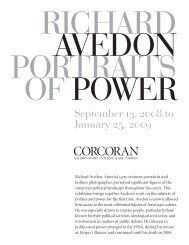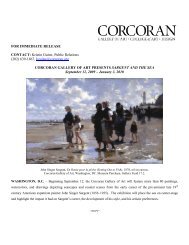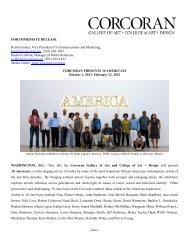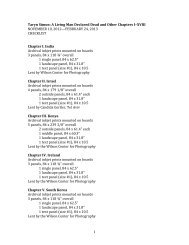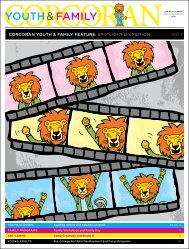Aaron Douglas, Into Bondage, 1936 - Corcoran Gallery of Art
Aaron Douglas, Into Bondage, 1936 - Corcoran Gallery of Art
Aaron Douglas, Into Bondage, 1936 - Corcoran Gallery of Art
You also want an ePaper? Increase the reach of your titles
YUMPU automatically turns print PDFs into web optimized ePapers that Google loves.
Marsden Hartley (born Lewiston, ME, 1877–died Ellsworth, ME, 1943)<br />
Berlin Abstraction, 1914/15<br />
Oil on canvas, 31 13/16 x 25 1/2 in. (80.8 x 64.8 cm)<br />
Museum Purchase, <strong>Gallery</strong> Fund, 1967<br />
About the <strong>Art</strong>ist<br />
Marsden Hartley was an important modernist artist <strong>of</strong> the early<br />
20th century. Born in Maine in 1877, he moved constantly throughout<br />
his adult life, never retaining the same residence for more than ten<br />
months. Alfred Stieglitz, photographer, art dealer, and director<br />
<strong>of</strong> the progressive <strong>Gallery</strong> 291 in New York City, was an early<br />
supporter <strong>of</strong> Hartley’s work. Inspired by the cutting-edge art<br />
exhibited in his mentor’s gallery and encouraged by Stieglitz,<br />
Hartley initially pursued an avant garde style <strong>of</strong> painting. However,<br />
he abandoned abstraction for almost two decades following<br />
World War I, only returning to it when he moved back to his home<br />
state in his later years.<br />
Hartley made a formative trip to Europe in April 1912. Two years<br />
later he spent several months in Paris and then traveled to Berlin<br />
to renew friendships with a young German lieutenant, Karl von<br />
Freyburg, and Freyburg’s sculptor cousin, Arnold Ronnebeck.<br />
The urban metropolis immediately captivated the artist, who<br />
hailed it “without question the finest modern city in Europe.”<br />
Several months later, von Freyburg was killed on the Western<br />
Front <strong>of</strong> World War I, plunging Hartley into a deep depression.<br />
Berlin Abstraction, part <strong>of</strong> the larger “War Motifs” series, was<br />
one <strong>of</strong> the resultant paintings.<br />
About the <strong>Art</strong><br />
Berlin Abstraction’s colorful patterns and numbers represent Hartley’s<br />
fallen friend, Karl von Freyburg. By choosing not to eulogize von<br />
Freyburg with a traditional portrait, Hartley made a painting whose<br />
message is conveyed by signs and symbols. The red number 4<br />
on the yellow epaulet refers to the Fourth Regiment <strong>of</strong> the Kaiser’s<br />
guard, in which von Freyburg fought and died; the blue curlicue E<br />
stands for Queen Elisabeth <strong>of</strong> Greece, the patron <strong>of</strong> Ronnebeck’s<br />
brigade; the red and white checkerboard alludes to von Freyburg’s<br />
love <strong>of</strong> chess; and the blue and white diamond pattern signifies<br />
the Bavarian flag. The central black cross may suggest the Iron<br />
Cross, a military decoration for bravery awarded to von Freyburg<br />
shortly before he died.<br />
On another level, the painting’s primary colors and sense <strong>of</strong><br />
movement also express the imperial pageantry and new modernity<br />
<strong>of</strong> Berlin that so enthralled Hartley. He was deeply impressed<br />
by the city’s orderliness and cleanliness, qualities he attributed to<br />
the armed forces’ presence. The deep reds, yellows, whites, and<br />
blacks describe the <strong>of</strong>ficers’ eye-popping uniforms and the bold<br />
flags and draperies <strong>of</strong> the military parades.<br />
The second decade <strong>of</strong> the twentieth century was a period <strong>of</strong><br />
fervent artistic innovation, and Hartley participated in the radical<br />
new styles sweeping across Europe. Berlin Abstraction synthesizes<br />
the new pictorial language <strong>of</strong> abstract art, fusing the emotionalism<br />
<strong>of</strong> Symbolism with the look <strong>of</strong> Synthetic Cubism. Unfortunately,<br />
Berlin Abstraction and the other paintings in Hartley’s War Motifs<br />
series were poorly received in America. They were exhibited in<br />
1916 at <strong>Gallery</strong> 291, but with the United States embroiled in a war<br />
with Germany and sensitivities running high, many criticized the<br />
perceived pro-German message. Hartley claimed that the series<br />
had no political underpinnings and “no symbolism whatsoever.”<br />
It was only after his death that the private nature <strong>of</strong> these paintings<br />
was discovered.<br />
Suggested Dialogue<br />
• Why did Hartley choose not to paint a straightforward portrait<br />
<strong>of</strong> his deceased friend, Karl von Freyburg?<br />
• Can the numbers, colors, and patterns that symbolize various<br />
aspects <strong>of</strong> Karl von Freyburg’s life take on meanings not intended<br />
by Hartley? Are there any that resonate with you or remind you<br />
<strong>of</strong> your own experiences?<br />
• Imagine that you were to create a painting or sculpture that<br />
would represent important aspects <strong>of</strong> your life through signs<br />
and symbols. What are important interests for you? What signs<br />
and symbols would you choose to represent important facets<br />
<strong>of</strong> your life? Do you think your friends or family would be able<br />
to “read” your work <strong>of</strong> art and recognize attributes that<br />
symbolize you?<br />
Extended Dialogue<br />
• Can abstract art tell a story? How?<br />
• How do artists arrange patterns and shapes to create a narrative?<br />
Do color choices affect our interpretation? Can brushwork<br />
communicate such things as calm serenity or violent speed?<br />
How can other elements <strong>of</strong> art and design contribute to narratives<br />
in abstract work?<br />
Vocabulary<br />
Avant-garde: French for the “advance<br />
guard” or the “vanguard.” The term refers<br />
to experimental or innovative people or art<br />
works that push the boundaries <strong>of</strong> the<br />
accepted cultural norm.<br />
The Western Front: An armed frontier<br />
between lands controlled by Germany<br />
to the East and the Allies (France and<br />
the United Kingdom) to the West during<br />
World War I. The Western Front consisted<br />
<strong>of</strong> a system <strong>of</strong> trenches protected by<br />
recently invented barbed wire and<br />
machine guns.<br />
Epaulet: A type <strong>of</strong> ornamental shoulder<br />
piece or decoration used as insignia <strong>of</strong> rank<br />
by armed forces and other organizations.<br />
Bavaria: A state in southeastern Germany.<br />
Its capital, Munich, was a center <strong>of</strong> artistic<br />
production in the early twentieth century.<br />
Symbolism: An artistic movement<br />
popularized in France in the late 1800s.<br />
The denial <strong>of</strong> space and thus the denial<br />
<strong>of</strong> the illusion <strong>of</strong> reality is a major component<br />
<strong>of</strong> Symbolism painting. Another basic<br />
feature <strong>of</strong> Symbolist art is an interest<br />
in spiritualism.<br />
Cubism: Generally acknowledged to<br />
have been the most significant movement<br />
in 20th-century art, Cubism was created<br />
by Georges Braque (1882–1963) and<br />
Pablo Picasso (1881–1973) in the period<br />
1907–14. It abandoned the traditional fixed<br />
viewpoint which had dominated western<br />
painting for centuries, and instead<br />
explored a multiplicity <strong>of</strong> viewpoints<br />
to develop an accumulated idea <strong>of</strong> the<br />
subject.<br />
Synthetic Cubism: A later form <strong>of</strong> Cubism<br />
that developed around 1912 in which the<br />
Spanish painter Juan Gris (1887–1927),<br />
also played a vital role. In this style <strong>of</strong><br />
painting, the image was built up from<br />
pre-existing elements or objects, rather<br />
than being created through a process<br />
<strong>of</strong> fragmentation as in Analytical Cubism;<br />
color was also reintroduced.<br />
Support for <strong>Art</strong>s 101 materials is made possible in part by the Women’s Committee <strong>of</strong> the <strong>Corcoran</strong> and the DC Commission on the <strong>Art</strong>s and Humanities.


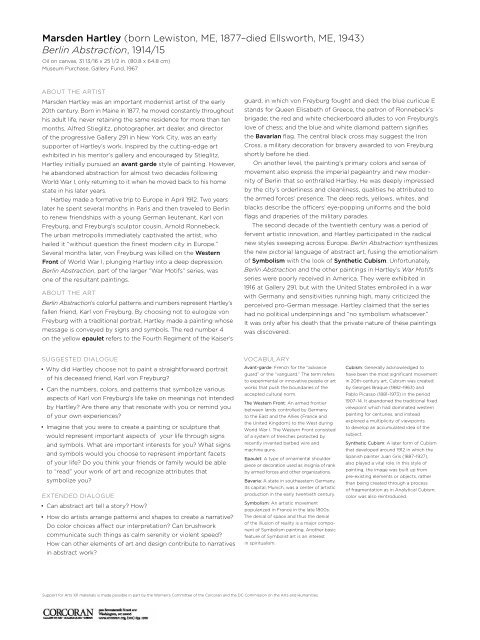
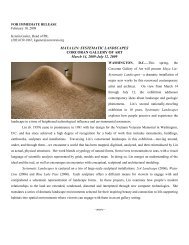
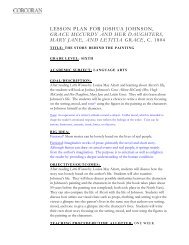
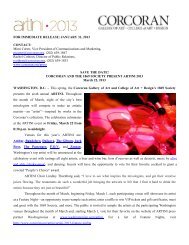


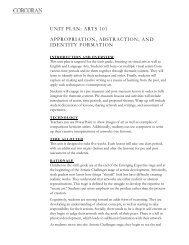
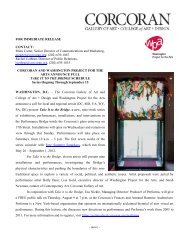

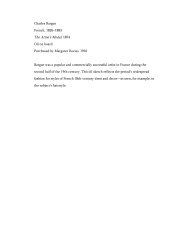
![[PDF] Ellen Harvey: The Alien's Guide to the Ruins of Washington, DC](https://img.yumpu.com/32942537/1/190x190/pdf-ellen-harvey-the-aliens-guide-to-the-ruins-of-washington-dc.jpg?quality=85)
